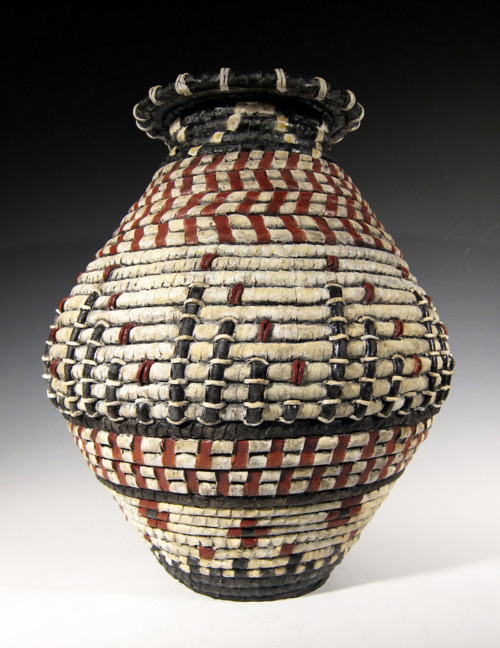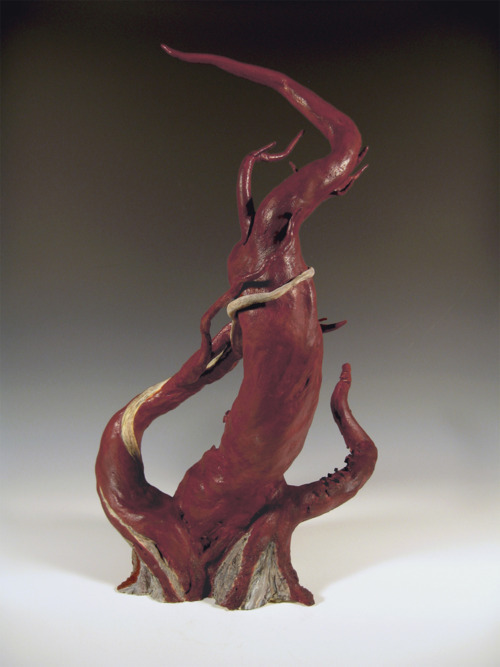
When and how did you discover the passion for ceramics?
Growing up, I was always the artsy-craftsy one, making things out of all different kinds of materials, using lots of different techniques. I loved going to my Dad’s office in New York City where they produced display products/props used in retail store windows and interior displays. To me, it was a magical, fantasy industry.
Though I never had art classes in high school, I decided that art would be my major in college. As a first year art student, I was introduced to clay. I immediately loved the tactile sense of working with clay and creating 3-dimensional objects.
My interest in clay took a back seat to advertising design which was my major within the art curriculum. This was followed by a very exciting career in commercial art designing decorative and functional display products for the retail stores, exhibit world, and point-of-purchase industries. Most of these products were 3-dimensional, large scale and fabricated from a variety of materials. It was always exciting and challenging to work with materials that had totally different commercial uses and to create products from them that were applicable to the display field. Much of this was done in foreign countries working with cottage industries, sometimes sitting on the ground outdoors with chickens and roosters strutting by.
Years later, when I retired and put my hands back into clay, I realized that this was a material that really excited and intrigued me, and one I had to explore in depth. I was hooked! My “clay play days” took over. Now instead of designing products that had to be marketable or meet a client’s design criteria, this was just me, the clay, and the creative process and didn’t need anyone else’s approval. I played with clay with a childlike approach, investigating, experimenting, and learning, as much and as fast as I could.
Tell us more about your creative process. Where do you get inspiration from and how do you find the journey towards the outcome?
My inspiration comes from just living and observing and being receptive to what is going on around me. I’ve always been inspired by the unlimited variety of textures, patterns, and energy found in nature. I love to be outdoors skiing, hiking, swimming, watching the changing light patterns from dawn to sunset, seeing flowers bloom and leaves unfurl. I’ll often take photos for reference, pick up pieces of bark to experience the sensation of the surface texture, and closely observe different patterns and details. I interpret my reaction to these things in clay. Though many of my artworks have a trompe l’oeil effect, I am not trying to mimic Nature. Rather, I try to bring the essence of what I have experienced in the outdoors into interior spaces.
Once in the studio, the clay often seems to have a life of its own as it leads me, morphing from one form and concept to another. On other occasions, I can envision the completed piece before even touching the clay.

You create baskets and figures of clay which surprisingly imitate the structure of reeds and grasses. What is the story behind the works and how did you discover this technique?
Observing trees, reeds, and grasses, all traditional basket making materials, led to my “Clay Baskets” series. These elements are all vertical, linear forms in nature but are mostly used horizontally when weaving baskets. I make my baskets using clay coils layered horizontally, forming sculptural shapes.
Caught up in the rhythmic, meditative flow of basket making, I realized how involved and interwoven, I, as the artist, was with the piece I was creating. What had started out as an idea to be made in clay had seamlessly evolved into a total integration of the artist and her art.
This realization led to a series of narrative figure pieces. As I learned more about the art and traditions of basket making, it became apparent that most basket makers were women. They were the ‘unsung heroes’ of the tribe or village. While the men, the hunters, and warriors, were often away from the village, the women tended the home front as the gatherers, nurturers, and teachers passing on traditions and stories from generation to generation. My basket figures, all women basket makers, tell these stories.
This figurative series made me aware that baskets need not only be utilitarian or attractive artworks, but that they could also tell a story. This turned out to be a much more challenging endeavor than I had anticipated, forcing me to think in the abstract. The series of the ‘4 Elements – Earth, Wind, Fire and Water’ took on a life of its own. As I was struggling with these pieces, someone brought to my attention that I, as the guiding hand, was the 5th element, Spirit, and was an integral part of the artwork. Once again, the artist and her art have become one.
My technique for creating these baskets is not woven at all. I layer extruded clay coil rings, scoring and slipping to make the tightest bond. Then by using a rubber chisel tipped tool, I work around each coil creating a woven effect. Other extruded pieces are surface mounted to give an additional dimensional effect. The pieces are then bisque fired, glazed, and fired.
It is said that, in order to become renowned, an artist has to be a good self-promoter. Do you consider yourself one, and are there recipes for that?
I think it‘s almost impossible for an artist to succeed today without doing self-promotion. Your work might be great, but if no one sees it, the work and the artist will never have a chance to be recognized. It’s hard work and time-consuming to market your art. It has to be an integral part of your clay work schedule. With today’s high-tech marketing tools, you have to have a presence, at least a website. It’s important to keep in mind that whatever you do to self-promote should reflect who you are and the quality of your work. All of this adds greatly to the perceived value of your work. Once again, the artist and her art are one.

Birch Still Life. Earthenware, acrylic cold finish, 13”H x 19”L x 12”D, 2010
What are you working on now? What are your plans?
At the moment, I’m still exploring my clay basket series and am starting to intertwine my tree theme with the basket concept. Also, whirling around in my mind is a new series of wall pieces that I envision will be close-up, abstract interpretations of tree bark. I’ve been taking detailed photos of many different tree barks and am fascinated by the graphic patterns I’m finding, as well as the variety of bark textures. And so, the journey continues…
By Andra Baban.
Published in Ceramics Now Magazine Issue 2.
View Kathy Pallie’s profile on Ceramics Now Magazine.
Visit Kathy Pallie’s website.




















